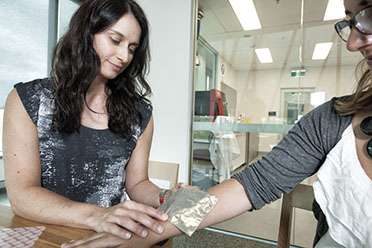3D model skin burnt to find better bandages for child burns victims

Skin reconstructed in a laboratory will be burnt and then blasted by a new state-of-the-art laser in the search to improve bandaging for children's burns, says leading burns and trauma researcher Dr Leila Cuttle.
Dr Cuttle is a senior research fellow at QUT's Institute of Health and Biomedical Innovation and heads a team of researchers in collaboration with the Queensland Children's Medical Research Institute.
"Silver dressings are standard care for children's burn wounds to reduce bacterial infection while silicone dressings ameliorate the scarring after deep burn injuries," she said.
"Little is known of how deeply their components penetrate the skin or how much silver and silicon remain behind in the skin."
Dr Cuttle said the project should find answers as to where and why the products stayed in the skin tissue.
She said her research complemented a clinical trial at the Royal Children's Hospital in Brisbane.
Almost 100 children who presented to the hospital with acute burns over a 12-month period were treated with silver bandaging and their progress was monitored.
"We want to understand what the active components of these dressings are doing to the tissue and how much of them remain behind after the dressing is removed," Dr Cuttle said.
"We need to know if that can be detrimental to the skin, or if they are required to decrease scarring."
Seven hundred children with new burns injuries are treated at the Royal Children's Hospital each year and many require ongoing treatment for scarring throughout their lives, Dr Cuttle said.
The new project uses the latest technology from QUT's Central Analytical Research Facility (CARF), including a laser which is coupled to a mass spectrometer.
Dr Charlotte Allen is a senior research fellow who will analyse the results with Dr Cuttle.
Dr Allen said the laser vaporised the skin and the mass spectrometer determined the concentrations of elements like silicon, calcium and silver.
"It uses mass spectroscopy to determine gradients in elemental concentration across very small distances," Dr Allen said.
The project is overseen by QUT's Tissue Repair and Regeneration Program led by Dr Tony Parker.
"This is the first time the instrument will be used on skin samples as it has previously been used to blast and analyse rocks and steel," he said.
"For this experiment you burn the skin model and then use pieces of silver bandage on the model as a dressing.
"We look at whether the compounds are biologically active and whether they facilitate rapid or effective treatments and how long they remain in the skin cells and whether that may be harmful or not."
QUT research associate Dr Jacqui McGovern will create the skin models using discarded skin from cosmetic surgery operations.
"The skin will be grown over two weeks and cut into squares two centimetres in size before it is burnt by a heated rod and dressed over a six-day period," she said.
Dr Cuttle said silver and silicone dressings were generally effective treatments, but further improvements may be made as a result of more research.
"We are constantly striving to create better treatments for children with burn injuries to enable them to heal faster and with less scarring," she said.
Dr Cuttle said preliminary results should be ready by the end of the year before the opening of the new Lady Cilento Children's Hospital in Brisbane.

















